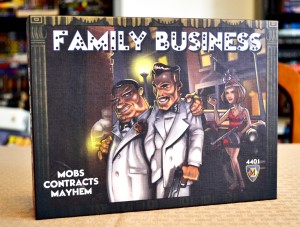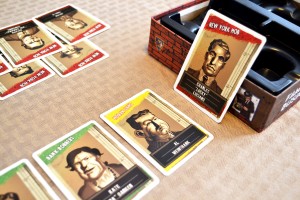I had a blast playing “Family Business” during the International TableTop Day event at Game Masters…though I admit, it helped to have some patient teachers. “Family Business” is an elimination game, through and through. You’ll receive a mob of gangsters and it’ll be your job to make sure that your family is the last one standing. To do that, you’ll have to avoid being placed on the hit list…it’s tougher than it sounds. Before we take a quick look at the game, I’d like to offer a special thank you to Jason, Charity, Barry, Joseph, and Kaleem (participants in the above-mentioned event) for taking the time to bring this game to my attention.
Components
Mobster Cards – There are a total of fifty-four mobster cards, broken up into six families (colors) of nine mobsters each. The families and/or mobsters don’t have any special abilities, so choosing one family over the other would simply be for aesthetic reasons.
Action Cards – There are a total of fifty-eight action cards, broken up into attack (red), counter (blue), and rescue (green) cards. Counter cards are instants and can be played at any time (there are exceptions) while attack and rescue cards can only be played on your turn. To sum up what they do: attack cards add other players’ mobsters to the hit list (or do other nasty things), rescue cards help to remove your own mobsters from the hit list, and counter cards help to prevent an attack from taking place.
Setup & Gameplay
Game setup is fairly easy…pick a color and take the nine mobsters of that family, placing them face up in front of you. This is your “health pool”, if you will. The action cards are shuffled, with each player being dealt five cards to form their hand. The box top is used as “the wall” (I’ll explain later), so keep it nearby and make sure there’s an empty path in which to lay down a row of cards from said box when needed. The dealer goes first, with play proceeding clockwise.
On a player’s turn, they’ll draw a card from the deck. Once that’s done, they’ll have the option to either play or discard a card from their hand. Attack (red) and rescue (green) cards can be played on your turn, whereas counter (blue) cards can be played at any time. Should someone play a counter card, it immediately becomes their turn with play proceeding clockwise from there (possibly skipping some players). After playing a counter card, you’ll draw two cards (one to replace the counter and one because it is now your turn). At the end of a player’s turn, they should always have five cards in their hand.
The idea of this game is to add other players’ mobsters to the hit list in the hopes of eliminating them from the game. The first mobster to get added to the hit list gets lined up on “the wall”. Adding more mobsters to the hit list while there’s already someone on “the wall” will result in them forming a que leading to “the wall”/box via a single line/row. During a mob war, the mobster on “the wall” is eliminated at the beginning of a player’s turn with the next mobster in line being placed there in their stead. Needless to say you’ll want to encourage placing other players’ mobsters on the hit list while trying to prevent the same from happening to you. A player who is out of mobster cards (none in front of them or on the hit list) is eliminated from the game.
Luckily, mob wars only happen during special circumstances: 1) Playing a mob war card, 2) Playing a vendetta card, 3) Playing an ambush card, 4) Having six or more mobsters on the hit list, and 5) Having six or fewer mobsters left in the game. When no one is left on the hit list or when a truce card is played, the mob war ends (but could start back up again later down the line). The player left standing once everyone else has been eliminated, wins the game!
The above doesn’t cover all of the rules, but should give you a good idea as to how the game is played. For more information, you can check out the manual here:
http://mayfairgames.com/mfg-shop3/rules/MFG0454-Rules-V2_0.pdf
The Review
The components are fairly straight forward: cards, cards, and more cards. The quantity, colors, and text on said cards might seem overwhelming to first time players, but it’s actually very easy to understand. It took me perhaps five minutes to grasp the basic concepts, though this is the first time I’ve had someone teach me a game as opposed to learning it myself. Regardless, I’m confident I could have had a basic understanding of the game within ten minutes of reading the manual (which happens to be fairly short as well). Once one understands that family / mobster cards have no use beyond being interactive / movable life point counters, all they’d really need to learn is what the various action cards do.
When I first saw this game, I was intrigued by the whole elimination mechanic in that you lined mobsters up against a wall and eliminated them in turn. It gave me a sense of a ticking clock that was winding down fast. Since you can only play rescue cards on your turn, there’s a good chance that your mobster will be eliminated before you even get a chance to do so (especially when playing with a lot of people). There are plenty of cards that re-arrange the hit list, allow for substitutions, and prevent a contract from being placed from the get go, but there are also some cards that are truly nasty. One eliminates every mobster on the hit list for example, while another causes two mobsters to be eliminated every player turn…ouch!
As a whole, “Family Business” is easy to pick up and play. Despite the theme (eliminating mobsters), it’s very family-friendly and doesn’t feature any sort of violent card art. With that said, I’d only recommend this game to folks who aren’t easily offended for being singled out during a game. When placing contracts and adding folks to the hit list, you often have to choose who you’re going to target. This can be a recipe for disaster if you have a bad loser or two in the group…it’s even worse if they have a short fuse. While child appropriate, a parent may want to monitor or participate in the game to prevent any potential problems that might occur with this kind of elimination style gameplay. A mature group who can bypass those hard feelings will find a strategic element to the game as well as they attempt to shape the hit list to each individual’s benefit. All in all, this is a game I’d be happy to come back to on a regular basis.
Final Verdict: 8/10
—



